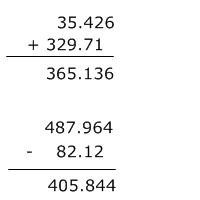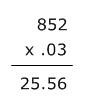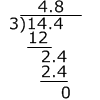Calculations with Decimals – Adding and Subtracting
When adding and subtracting decimals, be sure to line up the decimal places.
Study how the operations are performed in the illustration.

Calculations with Decimals – Multiplying and Dividing
You may not be allowed to use a calculator of your exam.
If so, you will need to know how to multiply and divide decimals by hand.
Look at the following examples:

Notice how the decimal in the result is two places from the right since the problem has a number with the decimal two places from the right.
Now look at an example of long division:

We can see that 3 times 4 is 12, so we put that below 14 and subtract.
We are left with 2.4 so we need to divide by 3 again.
The decimal in the answer is one place from the right, as it is in 14.4.
Decimals and Fractions
Decimals can be expressed as fractions and vice versa.
For example 0.5 is equal to five tenths.
Five tenths can be expressed as the following fraction: 5/10
We can check this answer by doing division.
The line in a fraction can be treated as the division symbol.
So, 5/10 = 5 ÷ 10 = 0.5
You will be asked to do these types of conversions on your exam.
Decimals and Percentages
Decimals can be expressed as percentages and vice versa.
For example 0.5 is equal to 50 percent.
To determine the percentage from a decimal number, move the decimal two places to the right, adding zeros where necessary.
To get the decimal from the percentage, put in a decimal two places from the right.
For example: 185% = 1.85
Determining the Greatest or the Least
You will also see questions on your exam that ask you which number from a list is the greatest or the least.
Look at the example below.
Which of the following is the least?
A) .32
B) .032
C) .23
D) .302
The correct answer is B.
You can check your answer by adding zeros as shown below:
A) .320
B) .032
C) .230
D) .302
Then remove the decimals and express the answers as whole numbers:
A) 320
B) 32
C) 230
D) 302
When the answers have been converted to whole numbers, we can easily see that 32 is the smallest.
You should also have a look at our other free exercises on:
- percentages
- fractions
- lowest common denominator
- mixed numbers
- ratios